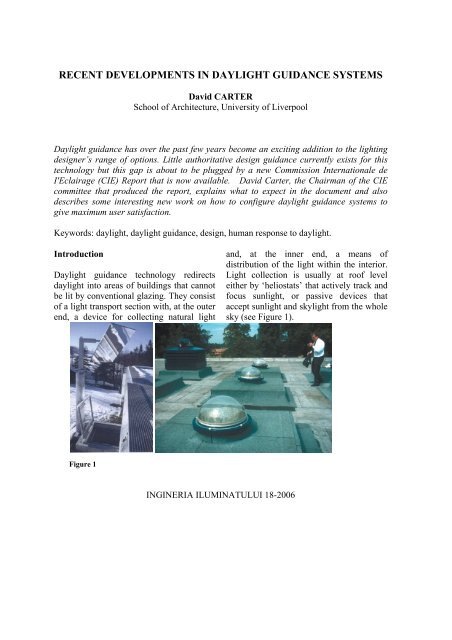This issue is sponsored by the Philips Romania, Lighting Division
This issue is sponsored by the Philips Romania, Lighting Division
This issue is sponsored by the Philips Romania, Lighting Division
You also want an ePaper? Increase the reach of your titles
YUMPU automatically turns print PDFs into web optimized ePapers that Google loves.
RECENT DEVELOPMENTS IN DAYLIGHT GUIDANCE SYSTEMS<br />
David CARTER<br />
School of Architecture, University of Liverpool<br />
Daylight guidance has over <strong>the</strong> past few years become an exciting addition to <strong>the</strong> lighting<br />
designer’s range of options. Little authoritative design guidance currently ex<strong>is</strong>ts for th<strong>is</strong><br />
technology but th<strong>is</strong> gap <strong>is</strong> about to be plugged <strong>by</strong> a new Comm<strong>is</strong>sion Internationale de<br />
I'Eclairage (CIE) Report that <strong>is</strong> now available. David Carter, <strong>the</strong> Chairman of <strong>the</strong> CIE<br />
committee that produced <strong>the</strong> report, explains what to expect in <strong>the</strong> document and also<br />
describes some interesting new work on how to configure daylight guidance systems to<br />
give maximum user sat<strong>is</strong>faction.<br />
Keywords: daylight, daylight guidance, design, human response to daylight.<br />
Introduction<br />
Daylight guidance technology redirects<br />
daylight into areas of buildings that cannot<br />
be lit <strong>by</strong> conventional glazing. They cons<strong>is</strong>t<br />
of a light transport section with, at <strong>the</strong> outer<br />
end, a device for collecting natural light<br />
Figure 1<br />
INGINERIA ILUMINATULUI 18-2006<br />
and, at <strong>the</strong> inner end, a means of<br />
d<strong>is</strong>tribution of <strong>the</strong> light within <strong>the</strong> interior.<br />
Light collection <strong>is</strong> usually at roof level<br />
ei<strong>the</strong>r <strong>by</strong> ‘heliostats’ that actively track and<br />
focus sunlight, or passive devices that<br />
accept sunlight and skylight from <strong>the</strong> whole<br />
sky (see Figure 1).
















